
1945-1950 NYC: Post-War Transition, Mid-Century Revival & Community Redevelopment
Post World War II, New York City emerged as a beacon of hope and prosperity. The end of the war in 1945 signaled not just a victory abroad but also the beginning of a significant transformation within the city. As soldiers returned, New York’s economy, buoyed by the post-war boom, began to flourish. This period saw a surge in employment and the development of the middle class, as industries shifted from wartime production to consumer goods. The city’s ports, teeming with activity, underscored New York’s pivotal role in international trade and commerce, solidifying its status as a global economic powerhouse.
The late 1940s were a golden era for New York City’s cultural landscape. Broadway theatres, having played a crucial role in boosting morale during the war, now basked in a renaissance, premiering iconic shows that reflected the optimism of the era. The art scene thrived, with abstract expressionism putting New York at the center of the art world. Institutions like the Museum of Modern Art and the Guggenheim, established during this time, became cultural landmarks, fostering a vibrant arts scene that attracted artists and aficionados from around the globe.
Urban development during these years was marked by significant projects aimed at addressing the city’s housing crisis and modernizing its infrastructure. The construction of Stuyvesant Town and Peter Cooper Village, large-scale residential developments, offered modern living spaces to thousands, emblematic of the era’s architectural and urban planning innovations. The United Nations Headquarters, completed in 1950, symbolized New York’s ascent as a center of global diplomacy and peace, enhancing the city’s international stature.
By 1950, New York City had not only recovered from the war’s devastation but had also begun to shape a new future. The city’s economy, culture, and urban landscape were undergoing profound changes, laying the groundwork for the modern metropolis it would become. This period of transformation would leave an indelible mark on the city’s history, reflecting its resilience, dynamism, and capacity for renewal.
Timeline of New York City’s History, USA
Timeline of New York City’s History 1945-1950
Discover surprising historical facts about The City That Never Sleeps—explore fun, educational insights into its history, population, iconic landmarks, and more, perfect for students, history enthusiasts, and anyone curious about NYC’s rich heritage.
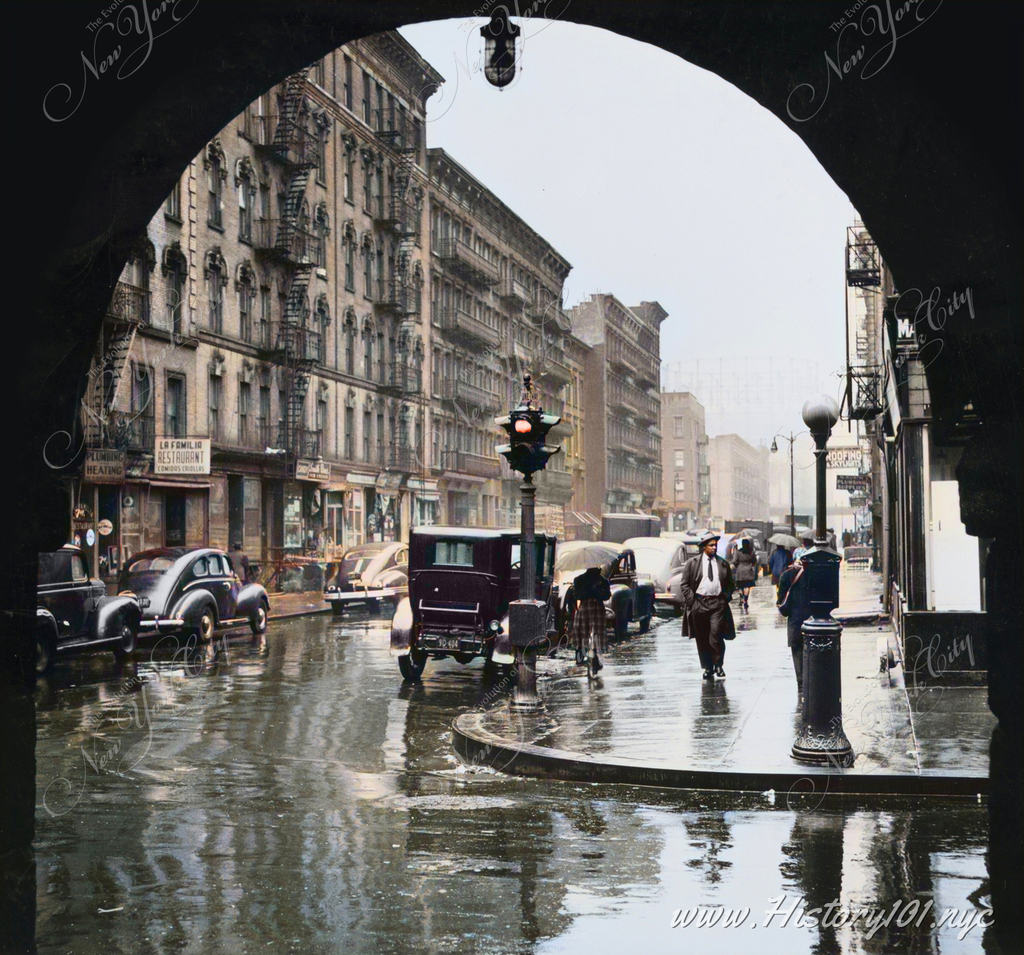
1947: Rainy Day in NYC: Al Aumuller's 110th Street from Park Avenue Photograph
Delve into Al Aumuller's 1947 iconic photo capturing a rainy day on 110th Street in NYC, a vivid window into mid-20th century urban life
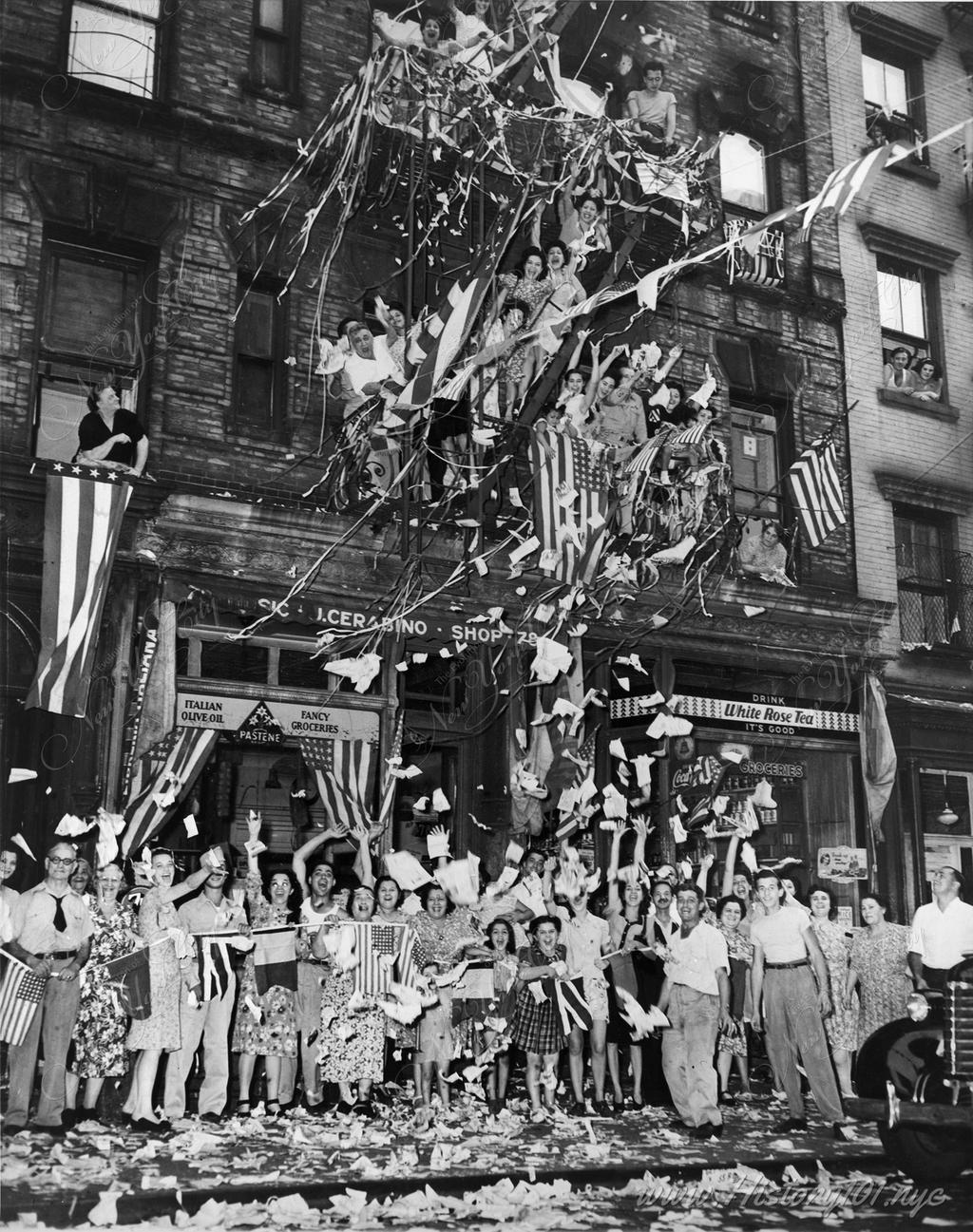
1945: Spirited Celebrations in Little Italy: The Pulse of Victory in NYC
Residents of New York's "Little Italy" in front of 78 Mulberry Street greet the news of Japan's acceptance of Allied surrender
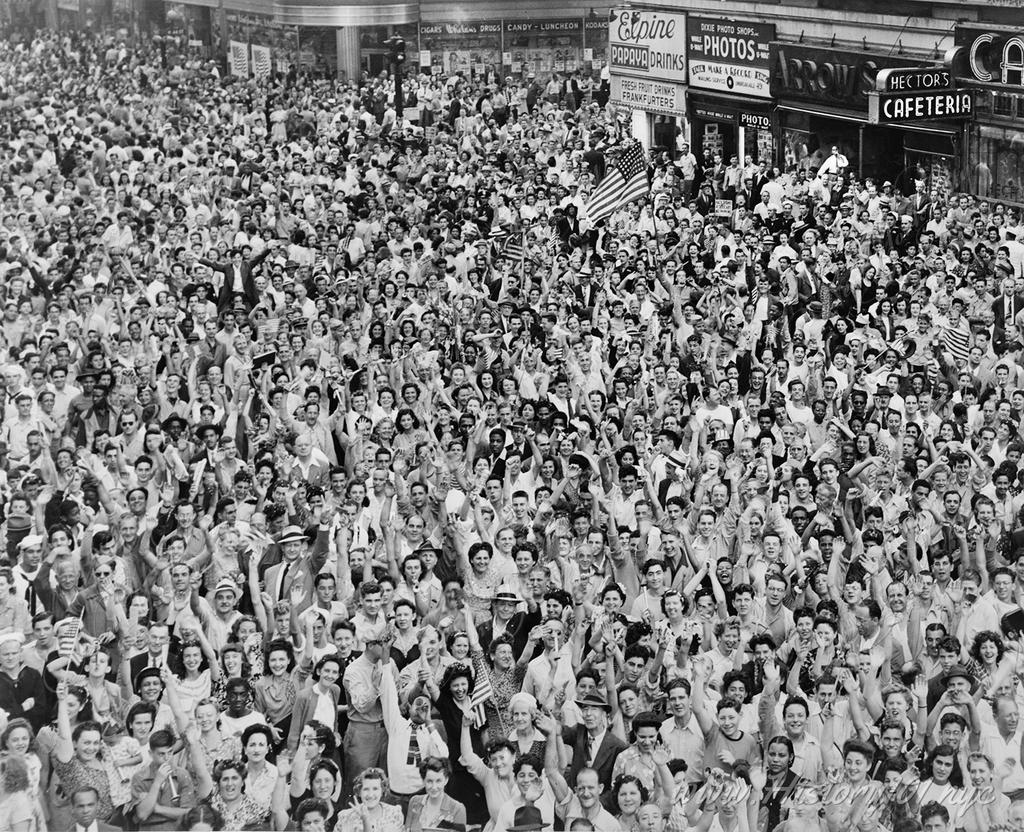
1945: Crowd at Times Square on V-J Day
Crowd of people, many waving, in Times Square on V-J Day at time of announcement of the Japanese surrender in 1945.
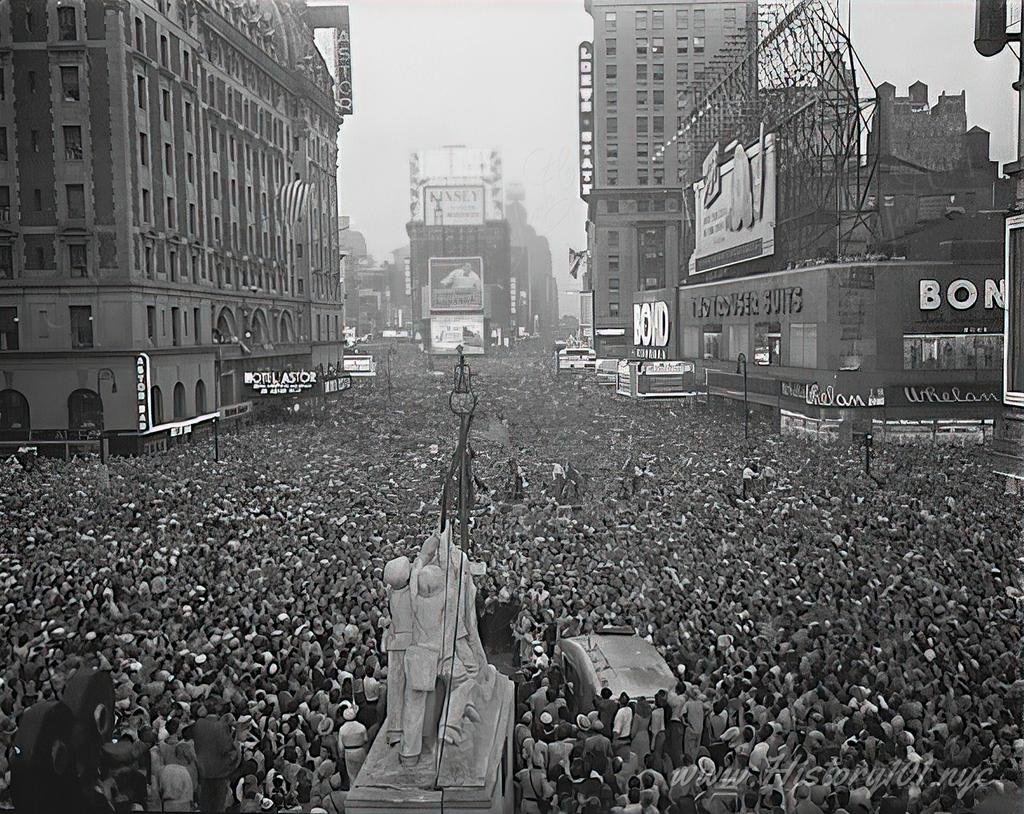
1945: Times Square Crowd Celebrates the Surrender of Japan
Crowds Gather in Times Square to Celebrate V-J Day (Victory over Japan Day) on Tuesday August 14, 1945
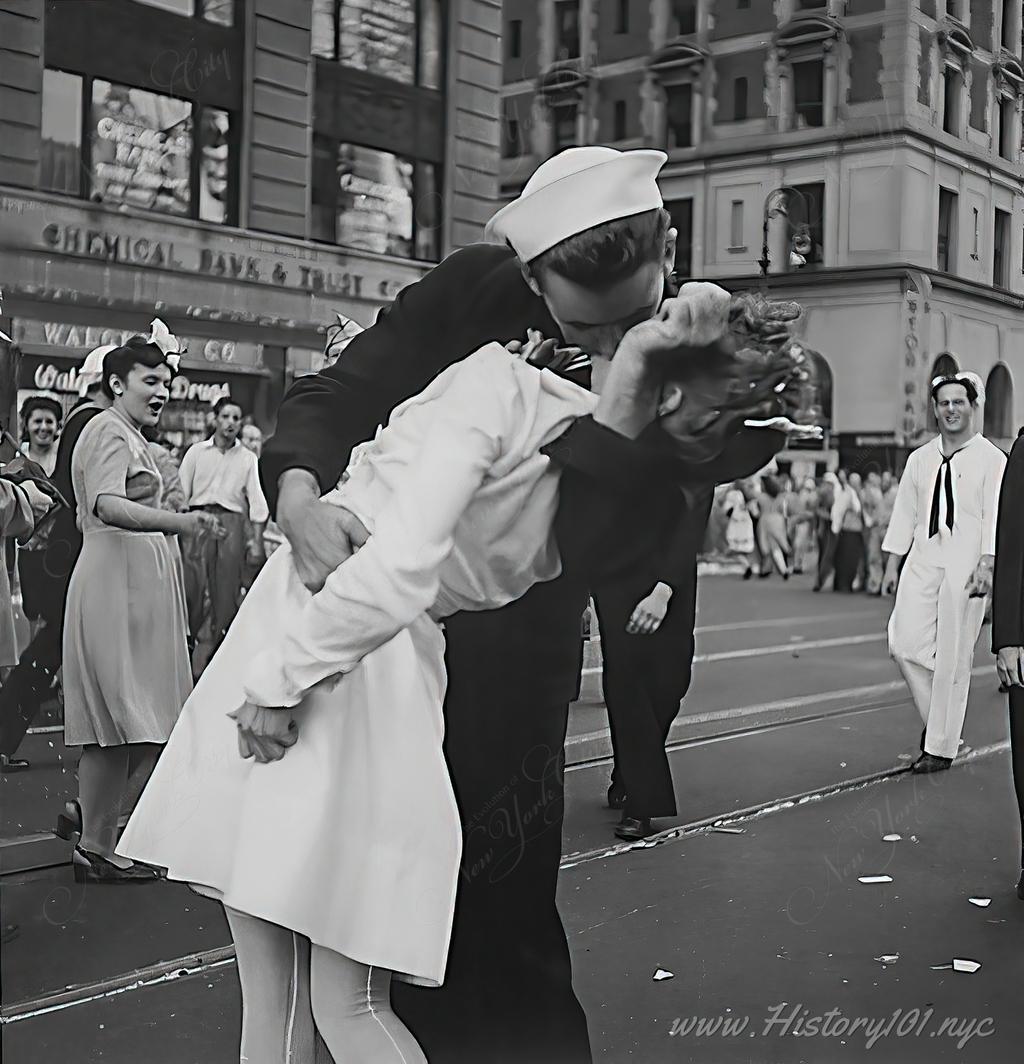
1945: Times Square's Most Famous Kiss: Unveiling History and the Real People Behind the Moment
Discover the true story behind the iconic V-J Day kiss in Times Square, captured by Alfred Eisenstaedt on August 14, 1945
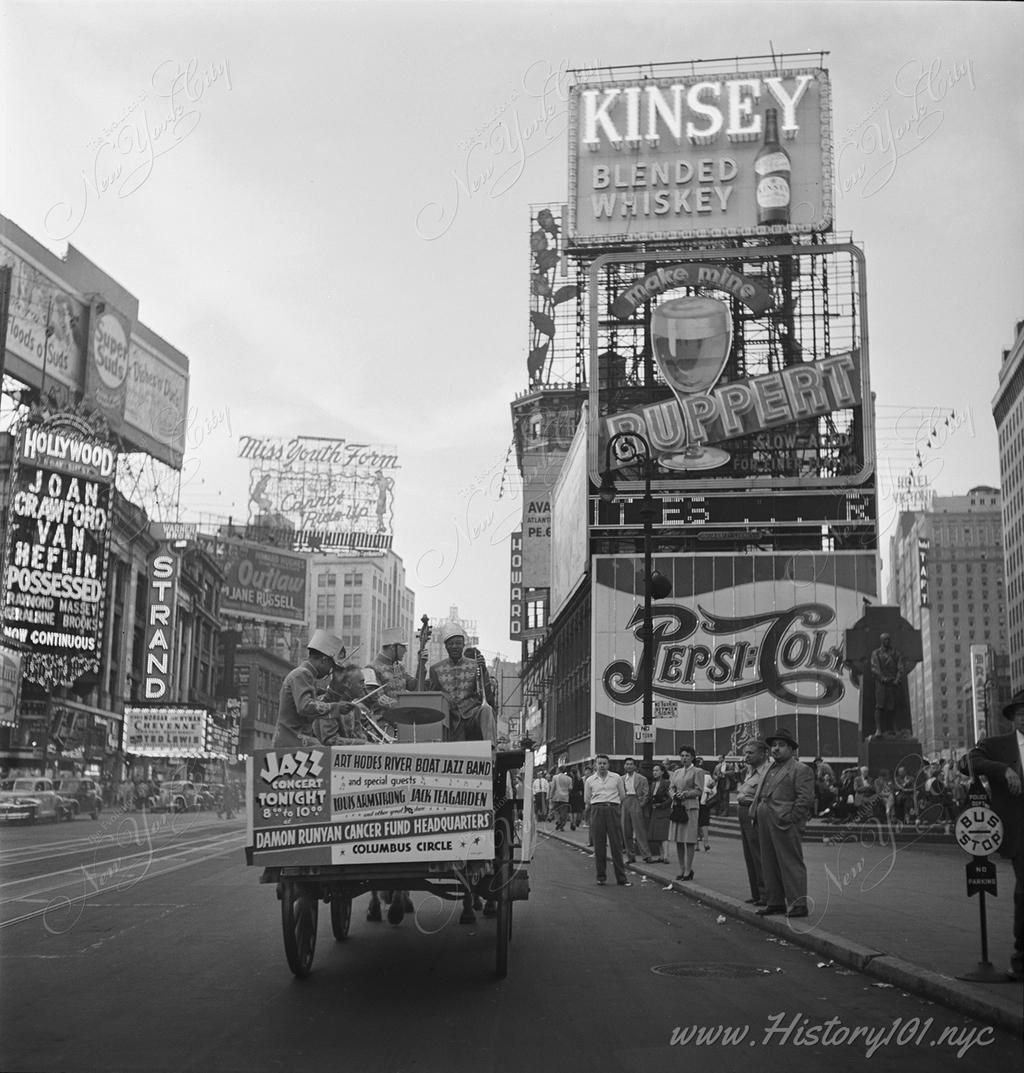
1947: Jazz Band at Times Square
A portrait of musicians Art Hodes, Kaiser Marshall, Henry (Clay) Goodwin, Sandy Williams, and Cecil (Xavier) Scott, playing on the back of a wagon in Times Square.
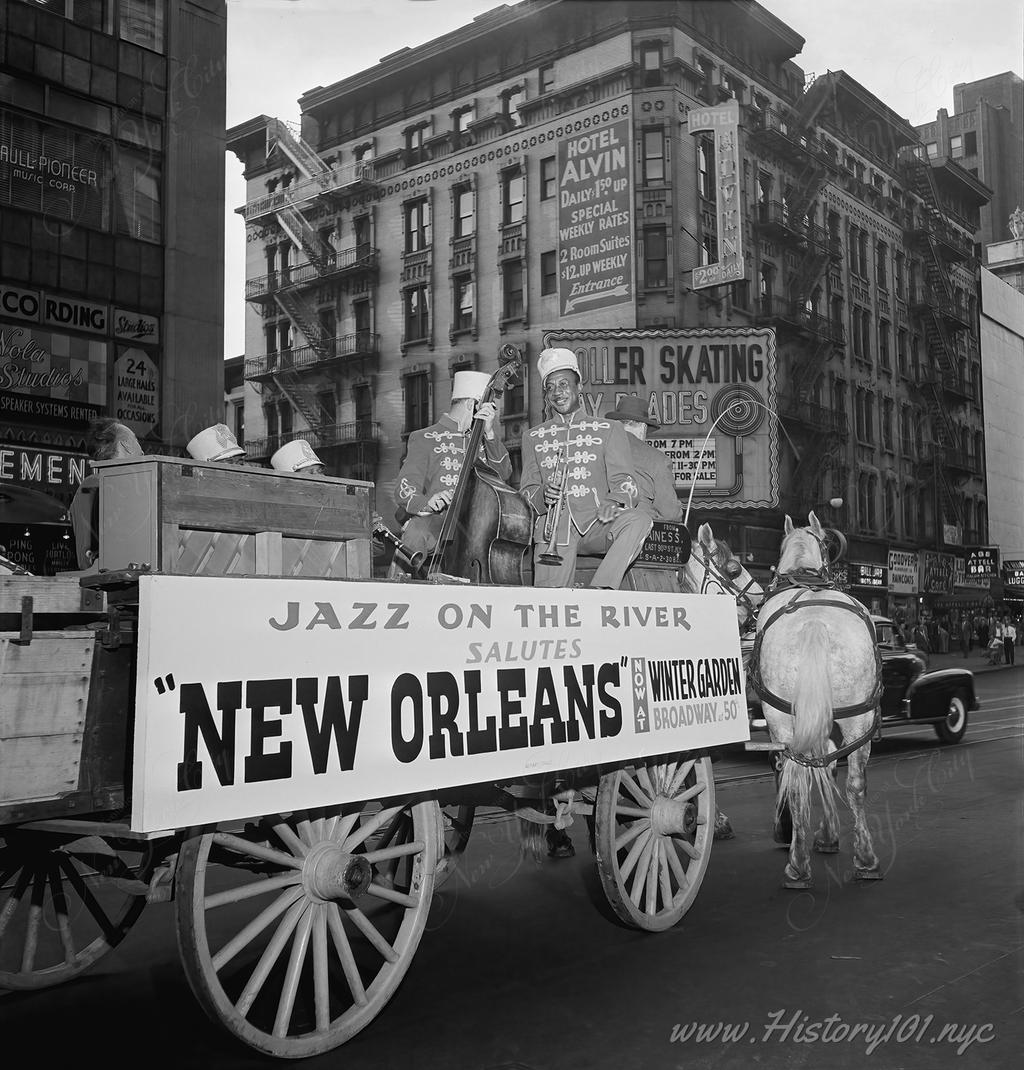
1947: Portrait of Jazz Musicians in Times Square
Photograph of jazz musicians Art Hodes, Kaiser Marshall, Henry (Clay) Goodwin, Sandy Williams, and Cecil (Xavier) Scott at Times Square.
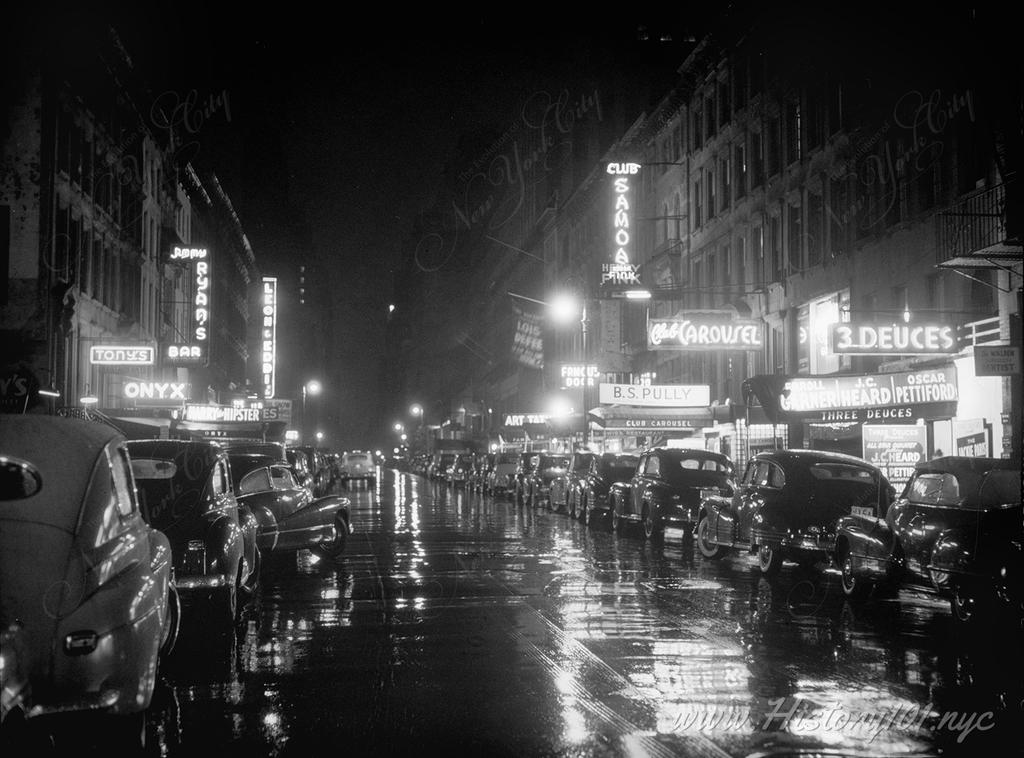
1948: 52nd Street at Night
Rows of parked cars reflect the neon lights of the bars and clubs on a rain-soaked 52nd Street.
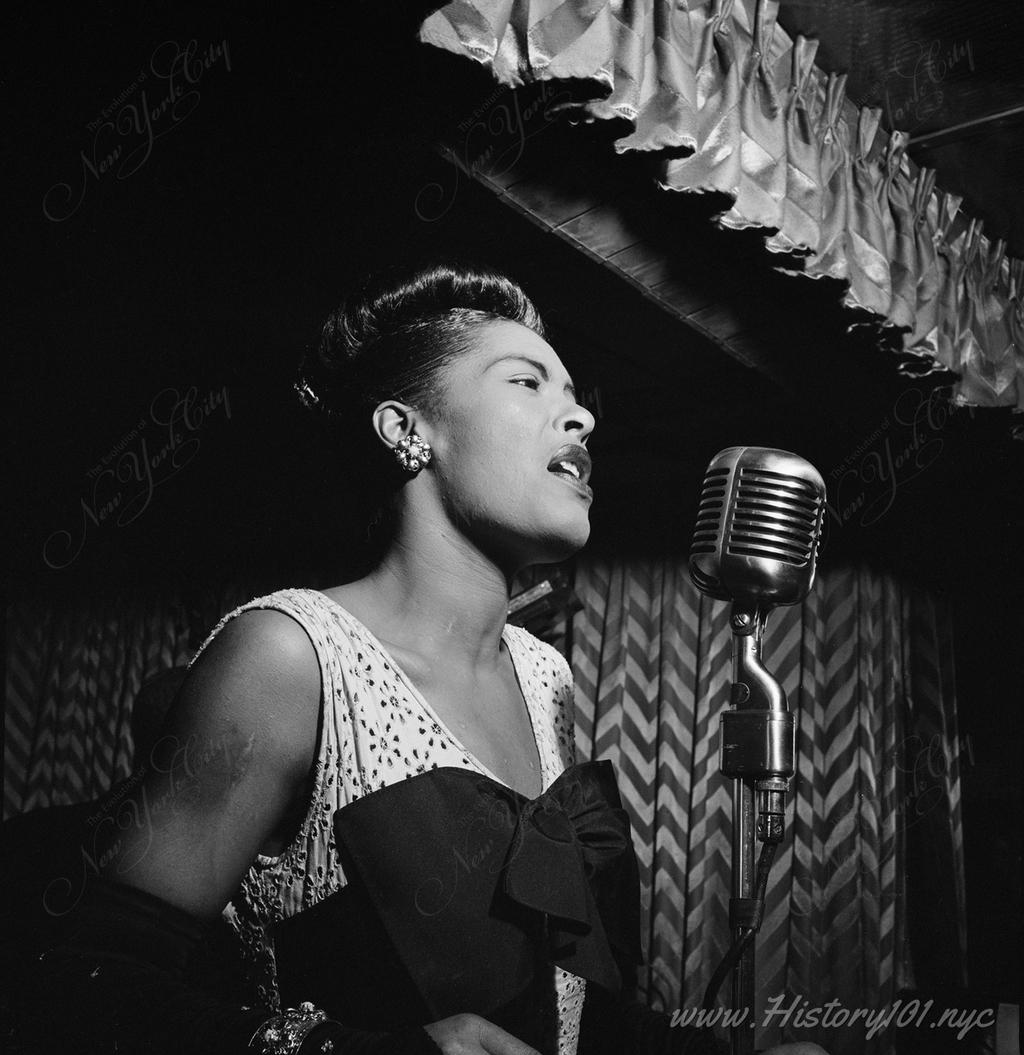
1947: Billie Holiday at Downbeat Club: Jazz History's Wider Lens
Explore a broader perspective of Billie Holiday's legendary 1947 performance at Downbeat Club, through the lens of jazz history
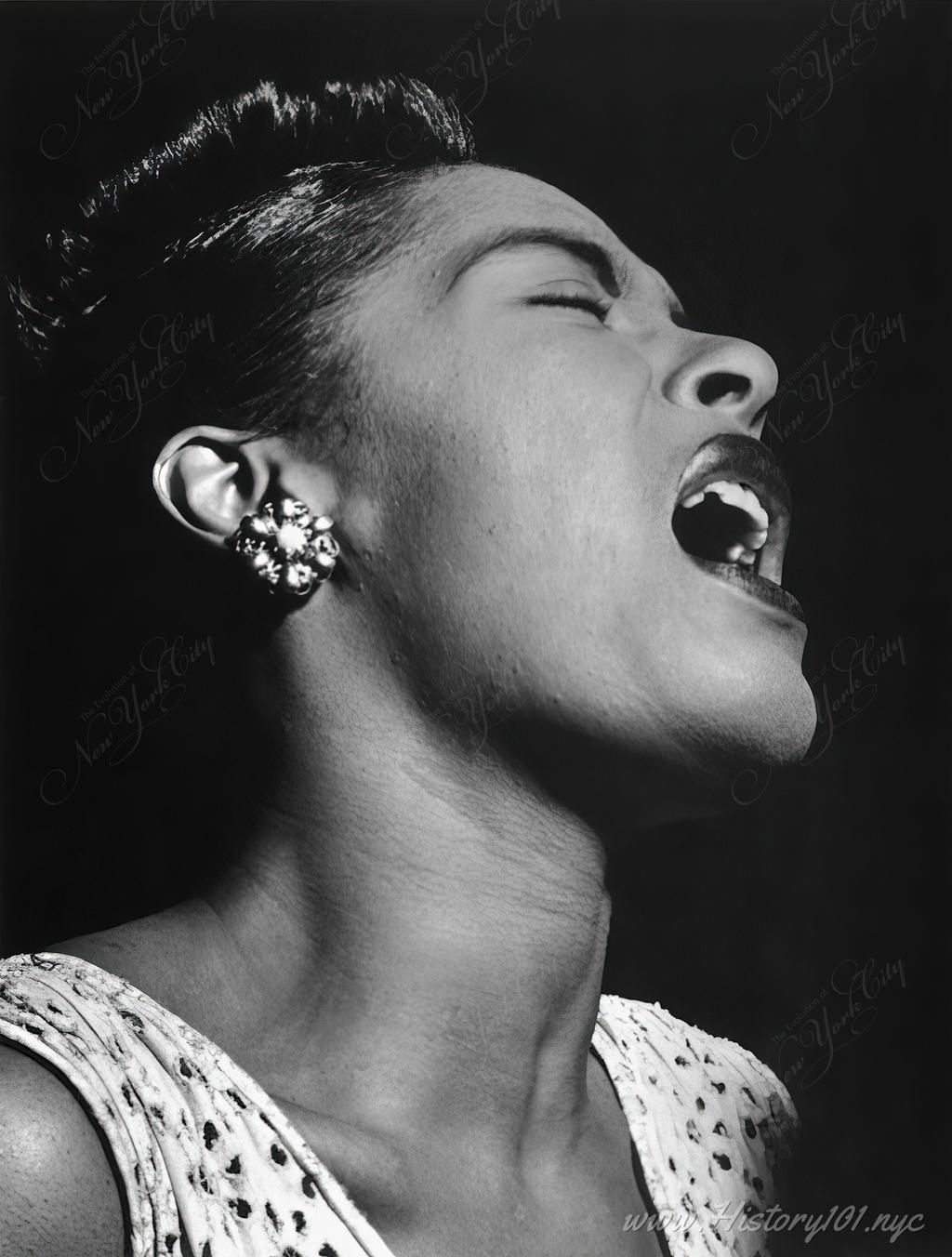
1947: Billie Holiday's Iconic 1947 Downbeat Performance: Captured by Gottlieb
Discover Billie Holiday's influential 1947 jazz performance at Downbeat, immortalized in William P. Gottlieb's iconic photograph
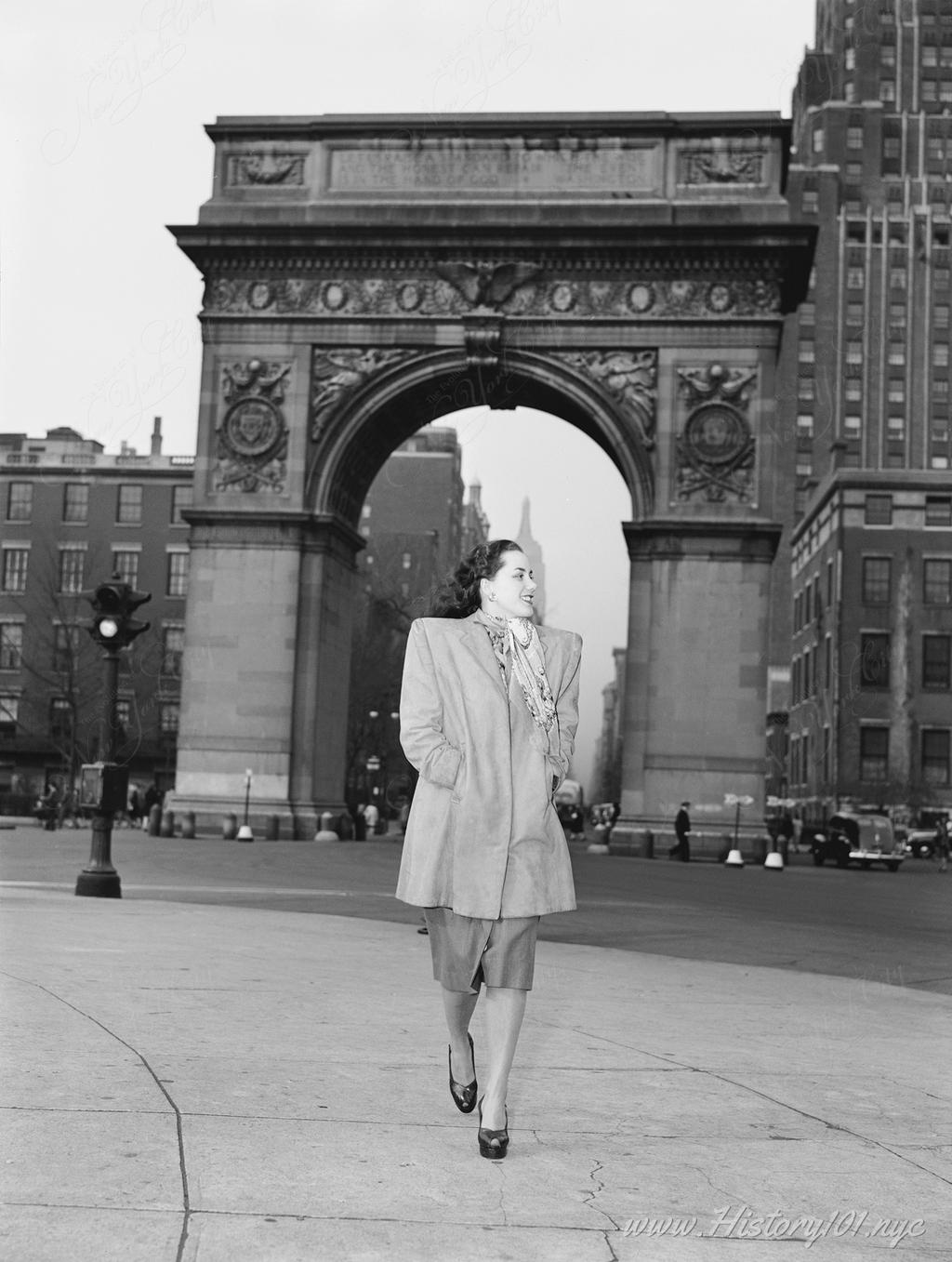
1947: Ann Hathaway: Unveiling the 1940s Jazz Legend's Legacy in NYC
Dive into the story of Ann Hathaway, a 1940s jazz singer who left her mark on NYC's music scene
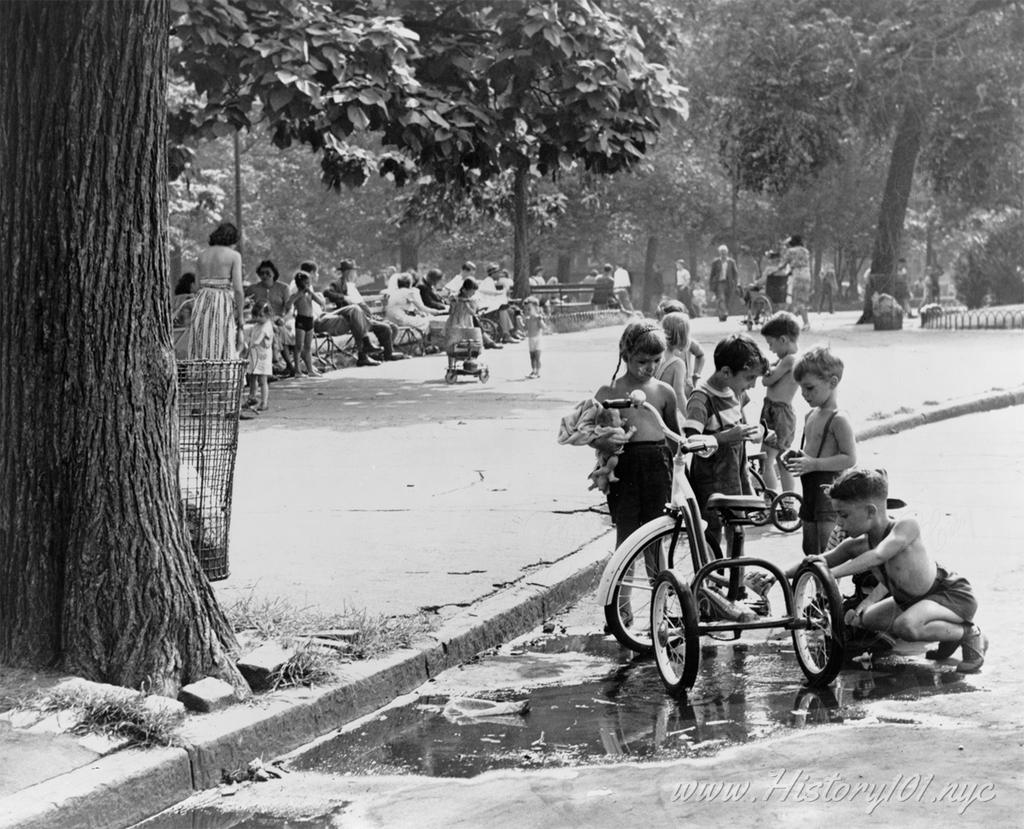
1948: Riding Tricycles at Washington Square Park
Photograph of youngsters with tricycles stopped at a puddle near a curb in Washington Square with people on benches in midground, trees behind them.
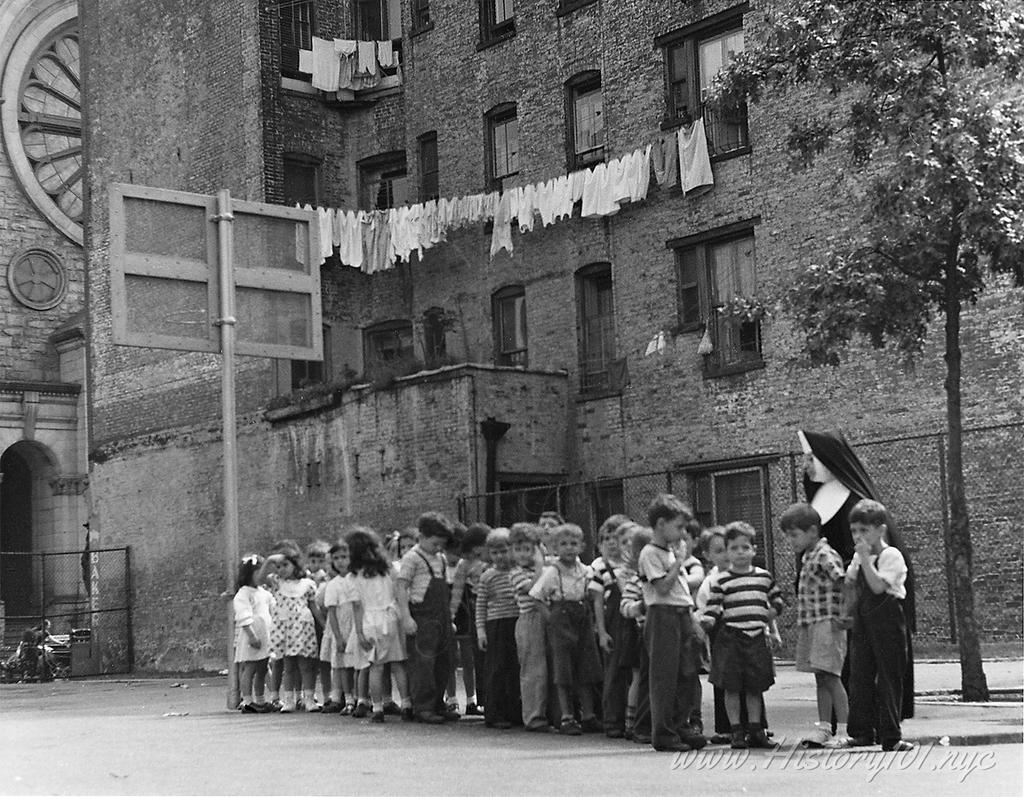
1949: Saint Anthony's Playground
Photograph shows a nun with a group of children on the basketball court at Saint Anthony's playground.
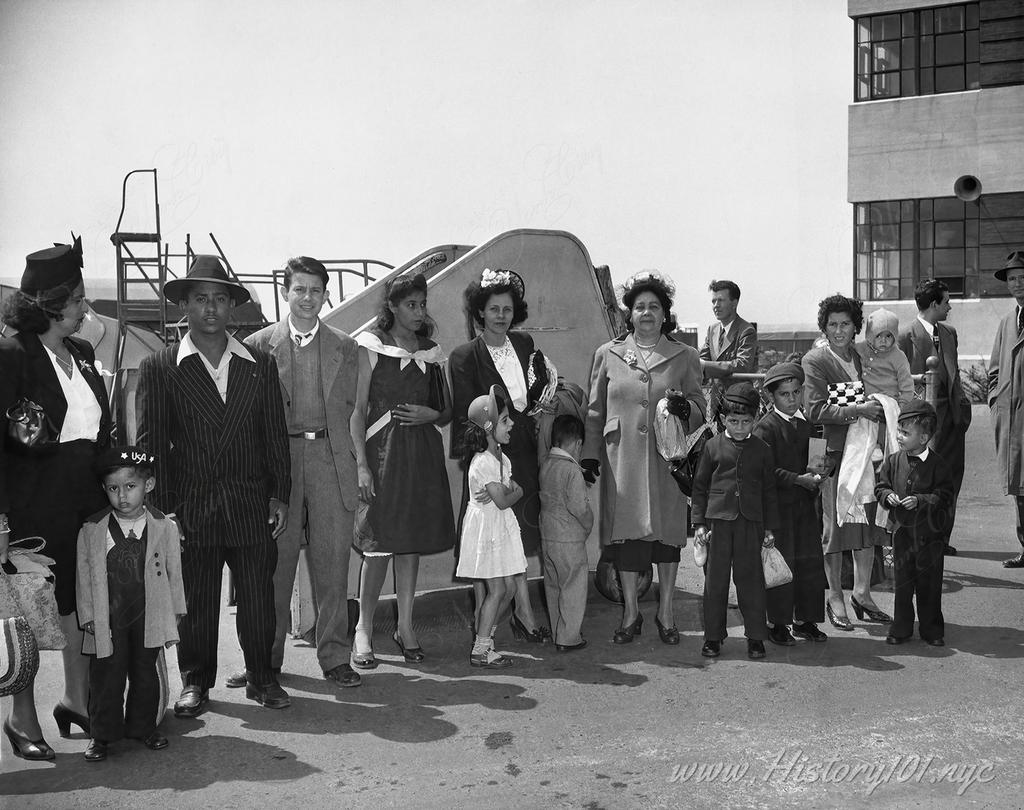
1947: Puerto Rican Family in New York City
Photograph shows a group of Puerto Ricans, at Newark airport, who just arrived by plane from Puerto Rico waiting to be transported to New York.

1945: Traffic on 37th Street
Long lines of delivery trucks stall traffic on the corner of West 37th Street, looking west from 7th Avenue, in front of Howard Clothes store.
Timeline of New York City: 1945-1950
1945: New York City was navigating the complexities of post-war adjustment, with its population estimated to be around 7.7 million, midway between the 1940 Census count of 7,454,995 and the 1950 Census count of 7,891,957. The city was experiencing shifts in its demographic and economic structures due to the end of World War II, which brought back thousands of servicemen and attracted new residents looking for opportunities in a reinvigorated peacetime economy. The distribution of the population across the boroughs continued to show the city's role as a magnet for both national and international migrants, drawn by its economic opportunities and cultural vitality. This period was crucial for setting the stage for the city's mid-20th century transformations, with efforts to expand housing and improve infrastructure to accommodate the growing and increasingly diverse population.
The year was pivotal for New York City's urban development and demographic trends. As the city transitioned from war to peace, it faced the challenges of integrating returning veterans and shifting from a wartime economy to one focused on consumer goods and services. These changes had significant implications for urban planning and development. The need for adequate housing, effective public transportation, and robust public services became even more pressing as the population grew. This era laid the groundwork for the city's future growth, setting the stage for its evolution into a global hub of finance, culture, and innovation.
1945: On August 14, Times Square in New York City became the backdrop for one of the most iconic photographs of the 20th century, capturing the spontaneous joy and relief marking the end of World War II on Victory over Japan Day (V-J Day). The famous images taken by Alfred Eisenstaedt and Victor Jorgensen each offer a unique perspective on this historic moment. Eisenstaedt’s photo, published in Life magazine, showcases the bustling scene of Times Square, symbolizing the collective national elation. In contrast, Jorgensen’s photograph, titled “Kissing the War Goodbye” and featured in The New York Times, zooms in on the intimate embrace of a sailor and a nurse, highlighting the personal joy and relief felt by individuals amidst the larger public celebration.
The identities of the figures in these photographs have been the subject of enduring intrigue and debate. George Mendonsa and Greta Zimmer Friedman are widely recognized as the sailor and the nurse in Eisenstaedt’s photograph, supported by forensic analysis and personal accounts. However, the claim by Glenn McDuffie, substantiated by forensic artist Lois Gibson, adds a layer of mystery and continued fascination with these images. Further personalizing the narrative, Rita Petry, who appears in the background of Eisenstaedt’s photo and later married Mendonsa, and Kay Hughes Dorius, identified as the woman in Jorgensen’s photograph, enrich the historical and emotional depth of these moments. These photographs not only document the jubilation of V-J Day but also weave individual stories into the broader tapestry of American history, serving as a powerful visual narrative of the day’s significance.
1945: The Bowne House, constructed in 1661 and one of the oldest existing structures in New York City, was transformed into the Bowne House Historical Society. This historic site, nestled in Flushing, Queens, holds a significant place in American history due to its original owner, John Bowne. Bowne is celebrated for his pivotal role in advocating for religious freedom; his defiance against the ban on Quaker worship in New Amsterdam led to his arrest and consequential trial. His courageous actions were crucial in shaping the principles of religious freedom that would later be integral to the U.S. Constitution. This transition of the house into a historical society was motivated by a commitment to preserve and highlight this profound legacy of championing civil liberties.
The establishment of the Bowne House Historical Society initiated a focused preservation of this critical element of New York’s colonial heritage, which later evolved into a museum. Today, the Bowne House not only acts as a testament to New York City’s early influence on religious and civil liberties in America but also serves as a vital educational tool. It sheds light on the historical and social narratives of its era and attracts scholars and visitors interested in the roots of American religious freedom. Situated in a diverse borough, the museum enhances the cultural and historical fabric of New York City, ensuring that John Bowne’s legacy and the historical importance of the Bowne House continue to resonate with and educate future generations. This enduring focus on preservation and education reaffirms New York City’s prominent role in historical and cultural conservation, enriching the community’s engagement with its deep historical roots.
1945: Adam Clayton Powell Jr. made history by being elected as the U.S. Representative for New York's 22nd congressional district. His election represented a significant milestone in American politics as Powell became one of the first African American politicians from a major urban center to serve in Congress. Prior to his political career, Powell was a pastor at the Abyssinian Baptist Church in Harlem, where he was an active advocate for civil rights and social reform. His transition from local activism to a national legislative platform was driven by his commitment to address and rectify racial inequalities and economic disparities affecting African Americans and other marginalized groups in New York City and beyond.
The election not only marked a crucial advancement in the representation of African Americans in political office but also underscored New York City's role as a burgeoning center for civil rights activism in the mid-20th century. His tenure in Congress saw significant legislative contributions, including efforts to expand access to education and labor rights, which had a lasting impact on both his constituents in Harlem and the broader American society. Powell's influential career in Congress, beginning with his election on this pivotal year, highlighted New York City's influence in shaping national policies related to civil rights and social justice, reinforcing the city’s historical and ongoing commitment to political and social progress.
1945: The United Nations headquarters in New York City stands as a pivotal landmark, not just architecturally but also historically, marking the city's role on the global stage. Initially, the U.S. Congress unanimously passed a resolution on December 10, inviting the UN to establish its permanent home within the United States. This was a key moment, aligning with broader efforts to find a suitable location for this new global entity in the aftermath of World War II. Subsequent discussions and evaluations of various sites across the U.S. led to a narrowing down of potential locations, focusing primarily on the East Coast, with New York City eventually emerging as the frontrunner due to its status as a vibrant international hub.
The decision to locate the UN headquarters in New York City was finalized a year later, on December 14, 1946, when the UN General Assembly accepted an $8.5 million offer from John D. Rockefeller Jr. to purchase the Manhattan site where the headquarters stands today. This site, once characterized by slaughterhouses and light industry, was transformed into a symbol of peace and international cooperation. The establishment of the UN headquarters in New York not only enhanced the city's international profile but also contributed to its economic and cultural development. By hosting such a significant international institution, New York City reinforced its standing as a global capital of diplomacy and multicultural exchange, influencing international policy and fostering global relationships from this strategic and symbolic location.
1945: On December 17, WABD, one of the pioneering television stations in New York City, transitioned from Channel 4 to Channel 5. This station, initially part of the DuMont Television Network, was integral in shaping the early television broadcasting landscape in the United States. The reallocation to Channel 5 was directed by the Federal Communications Commission (FCC) as part of its ongoing efforts to regulate and optimize the burgeoning television network system across the country. This shift was critical for WABD as it allowed the station to reach a broader audience and provided a more stable broadcasting frequency, enhancing the station's ability to deliver quality programming to viewers in the New York metropolitan area.
The move of WABD had lasting impacts on New York City's media and cultural landscape. As television emerged as a dominant media force post-World War II, having a foundational station like WABD solidly positioned on Channel 5 helped establish New York City as a major center for broadcast media. This adjustment not only facilitated WABD's growth but also contributed to the wider development of the television industry in the region, enhancing New York City’s role in the national media market. The station's successful reallocation underscores the city’s historical and ongoing commitment to supporting innovations in media and communications, which continue to shape its identity as a leading hub for technology and entertainment.
1946: Following World War II, New York City embarked on an ambitious public construction initiative to revitalize and expand its park and recreational facilities. Between 1946 and 1949, the city strategically allocated $22.5 million from its budget to address the critical need for urban green spaces and recreational areas. This funding was directed towards both the renovation of older parks and the creation of new playgrounds, meeting the growing demands of the city's expanding population. This period marked a significant shift in the city’s urban planning priorities, focusing on enhancing the quality of life for residents through the development of accessible and well-maintained public spaces.
The investment in New York City's parks and recreational facilities played a pivotal role in shaping the city's postwar landscape. It facilitated the construction of scores of playgrounds, which were often integrated with other public infrastructure projects such as schools, public housing, and highways. This integration was part of a broader urban development strategy that sought to create multifunctional public spaces that could serve diverse community needs. The enhancements made during this period not only improved the aesthetic and functional aspects of the city’s neighborhoods but also contributed to the social and physical well-being of its residents. By prioritizing the development of public recreational areas, New York City demonstrated a commitment to fostering more livable and engaging urban environments, which continue to benefit the community decades later.
1946: On January 12, New York City hosted a grand Victory Parade to celebrate the successful conclusion of World War II and the return of countless service members. The parade was a momentous occasion, symbolizing peace and the nation’s recovery from the long years of war. It wound through the streets of Manhattan, drawing vast crowds of spectators who came to honor the veterans and active duty personnel. The event was part of a broader series of victory parades across the United States, but New York's parade was particularly significant due to the city's prominence and its pivotal role during the war, serving as a major departure and return point for many soldiers.
The Victory Parade in New York City not only provided a cathartic celebration for the city’s residents and returning heroes but also reinforced New York’s position as a national symbol of resilience and unity. Coming together for such a large-scale public event helped restore a sense of normalcy and communal pride. It marked an important chapter in New York’s extensive historical narrative, serving as a demonstration of the city's capacity to unite people from all walks of life in recognition of a common cause. This event remains embedded in the city's memory, symbolizing the end of conflict and the beginning of a hopeful era of rebuilding and renewal, and continues to be a poignant reminder of the city’s historical significance during pivotal global events.
1946: On March 8, New York City became a trailblazer in urban transportation when it issued the first license for commercial helicopter use. This groundbreaking event marked the city's embrace of innovative aviation technology, setting a precedent for other cities worldwide. The introduction of commercial helicopter services offered a novel solution to the challenges posed by urban congestion, providing a faster, more efficient mode of transport that could easily traverse the city's dense and bustling landscape. This advancement was not only a significant achievement in the field of aviation but also a testament to New York City’s commitment to pioneering modern urban transportation solutions.
The licensing of the first commercial helicopter has had a lasting impact on New York City’s economic and logistical landscape. It opened up new avenues for business and tourism, allowing for quick aerial tours of the cityscape, faster commute options for business professionals, and an alternative for rapid response services. As the years passed, the use of helicopters became ingrained in the city’s transport infrastructure, enhancing its image as a dynamic metropolis at the forefront of technological integration. This move on March 8th highlighted New York's role as an innovator in urban transportation, contributing significantly to its history as a city that continually evolves to meet the needs of its residents and visitors.
1946: On June 6, the Basketball Association of America (BAA) was officially established in New York City, marking a significant development in the history of professional basketball. The creation of the BAA was instrumental in shaping the modern professional basketball landscape. This new league was formed by owners of the major ice hockey arenas in the Northeastern and Midwestern United States and Canada, seeking to fill their venues on non-hockey nights. By organizing the league in New York City, the founders took advantage of the city's media presence, vast audience, and substantial marketing opportunities, setting the stage for what would eventually become a major national sports organization.
The BAA's inception in New York City not only catalyzed the development of professional basketball but also reinforced the city's status as a pivotal arena for American sports. This establishment led to significant growth in the sport's popularity and professional organization, culminating in the merger with the National Basketball League (NBL) in 1949 to form the National Basketball Association (NBA). The strategic decision to base the BAA in New York leveraged the city's media and advertising capabilities, greatly enhancing the visibility and commercial viability of basketball. The founding of the BAA, in New York has had a profound and lasting impact on the city’s cultural fabric and economic dynamics, continuing to contribute to its identity as a world-leading city for sports and entertainment.
1946: On June 20, New York City made a significant upgrade to its public transportation system by introducing a public address (PA) system on subway car #744, which operated on the 8th Avenue Independent Subway (IND) line. This enhancement was part of the city's broader effort to modernize its extensive subway network. The implementation of the PA system aimed to improve communication with passengers by providing timely and clear announcements about stops, delays, and other critical travel information. This technological integration was particularly crucial for managing the large volume of passengers that the subway system handled daily, ensuring that they were well-informed during their commutes.
The introduction of the PA system into New York City's transit network not only marked an improvement in passenger communication but also significantly contributed to the operational efficiency and safety of the subway service. As the first car to feature this technology, #744 on the 8th Avenue line became a model for subsequent upgrades throughout the system. This initiative reflected New York City's commitment to leveraging technology to enhance urban transit services and passenger experience. By June, with this advancement, New York continued to solidify its reputation as a leader in urban transportation innovation, setting standards that would influence public transit systems globally.
1946: On June 25, a catastrophic fire erupted at the St. George terminal of the Staten Island Ferry in New York City, leading to a significant tragedy. The blaze resulted in the deaths of three people and injuries to 280 others, marking one of the darkest days in the history of the city’s ferry service. The fire not only caused considerable human suffering but also inflicted severe damage on the terminal infrastructure, disrupting ferry services that were crucial for daily commuters between Staten Island and Manhattan. This incident exposed serious safety vulnerabilities, prompting city officials and the public to reexamine and demand improvements in the safety measures of public transportation facilities.
The aftermath of the fire, spurred a series of changes in the operations and management of the Staten Island Ferry and the St. George terminal. The city took immediate steps to rebuild and modernize the terminal, implementing stricter safety protocols and emergency response procedures to prevent such tragedies in the future. The reconstruction of the terminal included enhancements in fire suppression systems and structural upgrades to improve overall safety and efficiency. These efforts not only restored confidence among the commuting public but also strengthened the infrastructure against potential future incidents. The rebuilding of the St. George terminal thus became a critical point in the history of New York City’s commitment to ensuring the safety and reliability of its transportation network, reinforcing the city’s resilience and adaptive response to crises.
1946: The Betty Parsons Gallery, a cornerstone in the promotion of American abstract expressionism, was established at 15 East 57th Street in New York City. The gallery was instrumental in launching the careers of several influential artists of the 20th century, including Jackson Pollock and Mark Rothko. Betty Parsons, renowned for her visionary approach, was among the first to recognize and support the nascent Abstract Expressionist movement. Her gallery became a focal point for innovative artistic expressions, showcasing groundbreaking works such as Pollock’s first drip paintings and Rothko’s early color field abstractions, which profoundly influenced the direction of American art.
Opening the Betty Parsons Gallery, shortly after the end of World War II, Betty Parsons contributed significantly to establishing New York City as a central hub of the global art scene. By promoting artists who were pushing the boundaries of contemporary art, Parsons helped shift the artistic epicenter from Paris to New York. This transition not only enhanced New York City's cultural prestige but also stimulated its economy through the growing art market. The gallery's role in promoting abstract expressionism mirrored the city's broader cultural evolution, underscoring its status as a place of rebirth and innovation. As such, Parsons and her gallery played a critical role in shaping both the cultural identity and the economic landscape of post-war New York, helping to forge an artistic legacy that continues to influence the global art community.
1946: On October 23, New York City hosted a pivotal moment in international diplomacy when the second session of the United Nations General Assembly convened at Flushing Meadows. This event marked the first time a UN General Assembly session was held in the city, which was a significant development in the post-World War II era as nations sought to strengthen international cooperation and peace. Flushing Meadows, which had previously hosted the 1939 New York World's Fair, was transformed into a stage for global dialogue and decision-making, bringing together representatives from various countries to address pressing international issues.
The convening of the UN General Assembly's second session in New York City, not only enhanced the city's global stature but also solidified its future role as the permanent home of the United Nations. This gathering at Flushing Meadows underscored New York's growing importance as a center for international affairs and its capacity to facilitate crucial diplomatic engagements. Hosting such a significant event helped to promote New York City as a key player in global governance and contributed to its rich history as a cosmopolitan nexus that continues to influence international relations and policies. This historical session was instrumental in shaping the city's identity as a vital hub for addressing global challenges.
1946: On November 2, a significant rebranding occurred in the New York City broadcasting landscape when Channel 2, initially known as WCBW, changed its call letters to WCBS-TV. This transition marked a pivotal moment in the station's history, aligning it more closely with the Columbia Broadcasting System (CBS), one of America's major television networks. This change not only streamlined the branding and operations of CBS’s television and radio outlets but also fortified the network's presence in one of the most influential media markets in the world.
The renaming of Channel 2 to WCBS-TV enhanced New York City's media profile, positioning the city even more prominently as a leader in broadcast innovation and quality programming. This strategic move helped WCBS-TV expand its audience reach and improve its programming quality, leveraging CBS's growing network of television content. By solidifying its connection with CBS, the station benefited from increased resources for news gathering, entertainment production, and technological advancements, thereby contributing significantly to New York City's reputation as a global media capital. This development on November 2nd played a crucial role in shaping the future of broadcast media within the city and nationally, reflecting the post-war expansion and evolution of the television industry.
1946: On November 2, a significant change occurred in the broadcasting industry of New York City when WEAF (AM & FM) radio stations officially changed their call letters to WNBC. This adjustment marked a pivotal moment in the evolution of media within the city, reflecting broader shifts in ownership and the strategic rebranding initiatives prevalent in the post-war era. Such transformations were not just about a new name; they were indicative of the increasing influence of major media conglomerates like NBC, or the National Broadcasting Company, which sought to consolidate its power and extend its reach across the American media landscape. The move helped solidify NBC's presence in one of the nation’s most competitive markets, ensuring its dominance in both national and local spheres.
The impact of this change on New York City was multifaceted, enhancing its reputation as a hub for media and entertainment. As home to NBC, the city bolstered its status as a leader in broadcasting innovation and standards, attracting talent and investment that spurred economic growth and cultural proliferation. This event was a stepping stone in confirming New York City’s role at the forefront of the American broadcasting industry during the mid-20th century. Such developments were crucial in shaping the city's identity as a media capital, influencing not only national but also international media trends. The strategic rebranding to WNBC on that November day played a key role in this historical trajectory.
1946: New York City's subway system experienced a pivotal year, marked by significant operational challenges and milestones that would shape its future. As the system continued to integrate routes from formerly private operators, city planners and transit authorities grappled with financial strains. These difficulties were compounded by the ongoing adjustments needed post-World War II, an era that had exerted considerable pressure on urban infrastructure across the United States. In Manhattan, the IRT Second Avenue Line saw further closures, a reflection of the shifting focus towards more sustainable and comprehensive transit solutions in the bustling city.
On December 23 of that year, the New York City subway set a record with a staggering 8,872,249 fares collected in a single day. This record ridership highlighted the essential role of the subway in daily commuter life and underscored its importance to the city's economic vitality. Such a high usage rate not only demonstrated the system's capacity to handle vast numbers of passengers but also emphasized the urgent need for ongoing investments in maintenance and modernization to meet the growing demands of New York City's diverse populace. This historical peak in ridership remains a testament to the subway's role as a lifeline for the city, connecting various boroughs and supporting the urban workforce efficiently.
1947: The Actors Studio founded in New York City, has become a cornerstone of American theater and film, renowned for its commitment to the method acting approach that reshaped acting techniques worldwide. Established by Elia Kazan, Cheryl Crawford, and Robert Lewis, and later influenced by Lee Strasberg's teachings, the studio fostered a new era of performance art that emphasized emotional truth and psychological depth. This approach deeply influenced not only theater but also the film industry, encouraging actors to explore complex character studies and authentic emotional expressions. The studio's innovative practices rapidly set new standards in acting, making it a pivotal institution in the evolution of performing arts.
The influence of the Actors Studio on New York City’s cultural landscape has been profound. By producing a plethora of talent that includes some of the most distinguished names in theater and cinema, the studio has enhanced New York City’s status as a global leader in the arts. Its location in Manhattan places it at the heart of the city’s vibrant theater district, contributing significantly to the cultural richness and artistic vibrancy of the area. The Actors Studio has not only shaped the careers of countless performers but also contributed to the broader artistic identity of New York City, cementing its reputation as a vital hub for creative innovation and theatrical excellence. This legacy continues to impact both the local cultural scene and the global perception of New York City as a center of artistic endeavor.
1947: In March, New York City was confronted with a serious public health threat when a man traveling from Mexico to the city was diagnosed with smallpox. Under the leadership of Dr. Israel Weinstein, the city’s Health Commissioner, officials launched an unprecedented vaccination campaign to prevent a widespread epidemic. Within just three weeks, over 6.35 million New Yorkers were vaccinated, with 5 million receiving their vaccinations within the first two weeks. This rapid and effective response was the largest mass vaccination effort for smallpox in U.S. history at that time, showcasing the city's ability to mobilize its public health resources swiftly.
The outcome of the vaccination effort was a resounding success. The total number of smallpox cases was limited to 12, with 10 individuals recovering and 2 fatalities. While the vaccine itself carried rare risks, including brain inflammation, the campaign was largely deemed effective, despite a few deaths attributed to the vaccination. The 1947 outbreak marked the last time smallpox occurred in New York City, solidifying the city's reputation for efficient public health responses and preparedness. This historic effort set a precedent for managing future health crises, underscoring the importance of swift action in densely populated areas.
1947: On March 25, a critical development unfolded in New York City that would cement its status as a global diplomatic hub. John D. Rockefeller Jr., through his son John D. Rockefeller III, presented an $8,500,000 check to Trygve Lie, the Secretary-General of the United Nations, earmarking the funds for the purchase of a six-block site along Manhattan’s East River. This significant financial contribution facilitated the acquisition of what would become the permanent headquarters of the United Nations. The event was marked by the presence of notable figures such as Robert Moses, New York City’s Commissioner of Parks and the coordinator of construction between NYC and the UN, alongside Mayor William O'Dwyer, highlighting the collaborative effort to establish this international institution within the city.
This strategic location for the United Nations not only bolstered New York City’s international profile but also had profound implications for its economic and cultural landscape. Establishing the UN headquarters here attracted diplomats, international businesses, and non-governmental organizations, boosting local industries and tourism. The presence of such a pivotal global organization fostered an environment of international cooperation and cultural exchange, enhancing New York City’s appeal as a center for global diplomacy. The establishment of the UN headquarters in 1947 on the East River site, secured through Rockefeller’s donation, has had lasting impacts, contributing to the city’s standing as a preeminent stage for addressing global issues and fostering international relationships.
1947: A landmark event in sports and American history occurred when Jackie Robinson broke Major League Baseball's color barrier by joining the Brooklyn Dodgers. Making his debut on April 15, Robinson became the first African American to play in MLB in the modern era. His entry into the league was not just a milestone for sports but also a significant moment in the civil rights movement, challenging the prevailing norms of racial segregation in America. Robinson's exceptional skill and courage under intense public scrutiny paved the way for other athletes of color to participate in major league sports.
Robinson's impact on New York City was profound, enhancing its image as a beacon of progressivism and diversity. His tenure with the Brooklyn Dodgers turned Ebbets Field into a symbol of racial integration and social progress. Throughout his career, Robinson faced and overcame enormous racial prejudice, embodying the resilience and diversity of New York City itself. His pioneering spirit and fight for equality helped to inspire broader societal changes, contributing to the city's historical narrative as a front-runner in cultural and social evolution. Jackie Robinson’s debut on that day in April later became celebrated as Jackie Robinson Day across all of Major League Baseball, underscoring his enduring legacy in the sport and society.
1947: On April 16, a groundbreaking technological advancement was demonstrated at the NBC studios in New York City, marking a pivotal moment in television history. The Jerry Fairbanks Zoomar lens, the first TV camera zoom lens of its kind, was showcased, introducing a new era in visual media. This innovation significantly enhanced the capabilities of television broadcasting by allowing for smooth, continuous close-up shots without the need for multiple camera setups. The Zoomar lens's ability to zoom in and out on subjects seamlessly revolutionized television production, making broadcasts more dynamic and visually engaging.
The introduction of this zoom lens technology in New York City reinforced its position as a major center for media innovation and broadcast technology. Hosting such a significant technological demonstration underscored the city's role as a pioneering force in the television industry, attracting further investments and talent to its already robust media sector. This event not only contributed to the evolution of television but also bolstered New York City's reputation as a hub for cutting-edge technological advancements, enhancing its economic and cultural landscape through increased opportunities in the media and technology sectors.
1947: On July 3, Grand Central Terminal witnessed an unprecedented surge in passenger traffic, marking a historical milestone in its operation. That day, a record-breaking 252,288 travelers passed through the terminal, setting a high-water mark for daily foot traffic that would stand for over five decades. This surge was primarily due to the onset of summer vacation, illustrating the terminal's crucial role in facilitating seasonal travel. Grand Central Terminal, known for its architectural grandeur and operational efficiency, has long been a vital hub in New York City's transportation network, capable of handling large volumes of passengers seamlessly.
This record event, not only highlights the operational capabilities of Grand Central Terminal but also underscores its significance in the social and economic fabric of New York City. Serving as a gateway for millions, the terminal has bolstered the city's image as a bustling metropolis and a central node in the national transportation grid. The ability to manage such high traffic volumes efficiently reflects the city's robust infrastructure and planning acumen. Events like these are pivotal in shaping the historical narrative of New York City, showcasing its enduring capacity to adapt to and manage the complexities of urban transit in a rapidly evolving world.
1947: On July 8, a significant historical event took place in New York City, marking the beginning of a new era in global diplomacy and urban transformation. The demolition of existing structures on the future site of the United Nations headquarters commenced, symbolizing the city's emerging role as a central hub for international affairs. This event was highlighted by a ceremony attended by notable figures such as Byron Price, the United States Assistant Secretary-General for Administrative and Financial Services; Hugo Rogers, Manhattan Borough President; and William O'Dwyer, Mayor of New York City. The trio participated in removing the first dozen bricks from a boarded-up five-story tenement building, officially starting the process that would lead to the construction of a complex dedicated to peace and cooperation among nations.
This development significantly bolstered New York City's international stature and economic vitality. The construction of the UN headquarters not only reshaped a portion of Manhattan's skyline but also reaffirmed the city’s strategic importance on the global stage. The presence of this major international institution has since attracted leaders, diplomats, and visitors from around the world, contributing to the cultural diversity and economic growth of the city. Hosting the United Nations has enabled New York City to play a pivotal role in facilitating important global dialogues and decisions, enhancing its reputation as a vibrant and influential metropolis committed to fostering international cooperation.
1947: Stuyvesant Town–Peter Cooper Village, a substantial post-war housing development in Manhattan, was conceptualized during World War II as a response to New York City's acute housing shortage that had been exacerbated since the Great Depression. Planning for this vast residential project began as early as 1942-43, spearheaded by the Metropolitan Life Insurance Company, which had already established a precedent with its Parkchester development in the Bronx, completed in 1942. By January 1945, Metropolitan Life had outlined extensive plans for Peter Cooper Village to accommodate 6,000 residents, extending east of First Avenue between 20th and 22nd Streets. This initiative was planned as an extension of the previously announced Stuyvesant Town, which was designed to prioritize the housing needs of returning veterans, giving them precedence in the application process.
The first building of Stuyvesant Town was officially occupied on August 1, welcoming its first tenants—two World War II veterans and their families—highlighting the project's dedication to serving those who had served in the war. This initial occupancy set a milestone in the city’s effort to provide affordable housing solutions in the heart of New York. Frederick H. Ecker, president of Metropolitan Life, remarked that the project would enable generations of New Yorkers to "live in a park – to live in the country in the heart of New York," emphasizing the development's unique blend of urban living with green spaces. The rapid uptake of available units, with 7,000 applications received on the first day alone, underscored the dire need for such housing and the project's immediate impact on addressing that demand. By integrating extensive green spaces and prioritizing the needs of veterans, Stuyvesant Town–Peter Cooper Village not only tackled post-war housing challenges but also set a benchmark for future urban housing developments in New York City.
1947: Fiorello La Guardia, one of New York City's most influential mayors, was renowned for his dynamic leadership and reformative approach, particularly during challenging times such as the Great Depression and World War II. His tenure as mayor from 1934 to 1945 was marked by vigorous efforts to combat city corruption and massive expansions in public infrastructure. La Guardia's policies significantly modernized New York City, enhancing everything from airports to parks, and his leadership was instrumental in the establishment of institutions such as the New York City Housing Authority, which provided affordable housing to thousands of New Yorkers. His efforts to improve the city's welfare systems and public health services reshaped New York's urban landscape, setting a standard for municipal governance.
On September 20, New York City bid farewell to this formidable leader when Fiorello La Guardia passed away from pancreatic cancer in the Bronx. His death marked the end of a pivotal chapter in the city's history, but his legacy continued to influence its development long after his passing. La Guardia's commitment to public service and his significant contributions to the city’s infrastructure development have left an indelible mark on New York City, embodying the resilience and progressive spirit that define it today. His leadership not only transformed the city but also solidified its reputation as a beacon of innovation and governance excellence, contributing to its status as a global metropolis.
1947: On December 3, the curtain rose on Tennessee Williams’ seminal play, A Streetcar Named Desire, at the Ethel Barrymore Theatre in New York City. This premiere marked a significant milestone in American theater, bringing to life a story that would resonate with audiences and critics alike for generations. Directed by Elia Kazan, the production featured performances by Marlon Brando, Jessica Tandy, Kim Hunter, and Karl Malden, whose portrayals added profound depth to Williams’ complex characters. The play's exploration of difficult themes such as mental instability, societal shift, and stark human emotions set a new standard for Broadway productions and had a lasting impact on American dramatic literature.
The successful debut of A Streetcar Named Desire added to New York City's illustrious history as the epicenter of the theatrical world, attracting further attention and talent to its stages. This groundbreaking production not only showcased the city’s cultural depth but also reinforced its status as a beacon for artistic innovation. By hosting such influential works, New York City continued to foster a rich, dynamic arts scene that contributed significantly to its identity as a global cultural capital. The premiere of Williams’ play in 1947 enhanced the city's reputation for premiering provocative and meaningful theatrical works, securing its place as a critical hub for anyone involved in or passionate about the performing arts.
1947: One of the most severe snowstorms in New York City’s history, struck with full force on December 25 and 26, blanketing the city in a record 25.8 inches of snow within just 16 hours. This sudden and intense snowfall overwhelmed the city’s capacity to respond quickly, leading to significant disruptions across all five boroughs. The storm halted transportation, closed businesses, and caused widespread power outages, effectively bringing the bustling metropolis to a standstill. The aftermath saw the city grappling with massive snow removal efforts, which were crucial in restoring normalcy and preventing further complications from the stagnant snow.
This historic blizzard not only tested New York City’s emergency response systems but also led to critical improvements in disaster preparedness and infrastructure resilience. The experience gained from snowstorm prompted city officials to overhaul strategies for snow removal and emergency management, ensuring a more effective response to similar events in the future. Additionally, the city's ability to recover and learn from such a disruptive event reinforced its reputation as a resilient urban center capable of handling extreme weather challenges.
1948: A pivotal year for public higher education in New York with the establishment of the State University of New York (SUNY) system through legislative action, supported by Governor Thomas E. Dewey's crucial endorsement. The system’s creation on April 22 marked the beginning of a transformative era in public education, reflecting New York’s commitment to investing in its future through sustained educational innovation and accessibility. The foundation of this system followed a detailed review by the Temporary Commission on the Need for a State University, led by Owen D. Young, then Chairman of General Electric. The enactment of this legislation granted SUNY broad educational authority, including the rights to inspect and regulate colleges, award degrees, manage funds, and execute other necessary corporate functions
This robust framework was designed to provide high-quality, accessible public higher education to a broad demographic across New York State, setting a precedent for state-supported education. The establishment of the SUNY system has had a long-standing impact, ensuring that higher education evolves in sync with the socio-economic needs of New York's diverse population. Over the decades, the SUNY system has expanded significantly, now encompassing a vast network of institutions that serve hundreds of thousands of students annually. This growth has been instrumental in fostering academic excellence and driving economic development throughout the state. By providing affordable, top-tier education, SUNY not only enhances the professional landscape but also contributes significantly to the intellectual and cultural enrichment of New York State.
1948: On July 1, New York City celebrated a major milestone in its aviation history with the opening of New York International Airport, initially known as Idlewild Airport. The airport's opening marked a significant expansion in the city's ability to handle international air travel. The first flight departed Idlewild on this day, while the first scheduled arrival, a DC-4 from Peruvian International Airlines, touched down on July 9 from Santiago, Chile. This facility replaced the Idlewild Beach Golf Course, taking its moniker from what is thought to be a Native American term "Idalwilde," meaning "peaceful but savage." The establishment of this airport was a crucial development, enhancing New York City's connectivity with the world and bolstering its position as a global hub.
The dedication of Idlewild Airport on July 31, was a grand event, attended by notable figures including President Harry S. Truman and New York Governor Thomas E. Dewey, and watched by an estimated 215,000 spectators. This celebration underscored the airport's importance to New York City and the broader region, heralding a new era of international travel and commerce. The presence of such high-profile leaders and the large crowd reflected the significant investment and high expectations placed on this new aviation hub. As Idlewild evolved into what is now known as John F. Kennedy International Airport, its impact on the city's economy and its role in international business and tourism have continued to grow, proving essential to New York City's status as a vibrant and dynamic metropolis on the global stage.
1948: WPIX TV channel 11, an influential independent television station, began broadcasting on June 15, from its studios housed in the iconic Daily News Building on 42nd Street in Manhattan. This station, owned by the Daily News, derived its call letters 'PIX' from the newspaper's tagline, "New York's PICTURE Newspaper," symbolizing its commitment to visual storytelling. As one of the initial television stations in New York City, WPIX has been a pioneer in the broadcast media landscape, significantly enriching the local cultural and informational milieu with a diverse range of programming that includes news, movies, and original shows.
The establishment of WPIX marked a pivotal development in the evolution of New York City's media scene. By providing varied and robust content, the station played a critical role in expanding the television industry within the city, enhancing the competition among local broadcasters. This competitive environment spurred innovation and led to improvements in the quality of programming, contributing to the cultural richness and dynamism of New York City. Over the decades, WPIX has maintained its significance in the city's broadcasting industry, reflecting and shaping the diverse cultural tapestry of one of the world's most vibrant urban centers.
1948: On July 1, New York City implemented a significant change in its public transportation fare structure, marking a pivotal moment in the history of the city's transit system. The subway fare was increased from the longstanding 5 cents, a rate that had been in place since the subway's inception in 1904, to 10 cents. Additionally, bus fares were adjusted to 7 cents, and a combined fare for using both the subway and bus services was set at 12 cents. This fare revision was essential for addressing the financial challenges faced by the transit system, which included rising operational costs and the need for ongoing maintenance and expansion to serve the city’s growing population.
The adjustment in fare was a critical step towards ensuring the sustainability and improvement of New York City’s public transportation system. By updating the fare structure, the city could better support the maintenance and expansion of its transit network, crucial for accommodating an expanding urban landscape and increasing commuter demands. This move also reflected the broader economic changes of the post-war era, where there was a need to balance the affordability of public transport with the financial realities of operating one of the largest transit systems in the world. The fare increase, therefore, not only helped stabilize the city’s public transportation finances but also facilitated enhancements in service and infrastructure, reinforcing New York City’s reputation as a dynamic urban center with robust public transit solutions.
1948: WPLJ, originally signed on as WJZ-FM on May 4, under a Construction Permit, marked a significant milestone in New York City’s broadcasting history. Initially the FM flagship of the American Broadcasting Company (ABC), the station underwent a pivotal transformation when it adopted the WABC-FM call letters on May 18, 1953. Over the decades, WPLJ evolved through various formats, from its progressive rock phase beginning in 1969 to its rebranding as WPLJ on February 14, 1971, embracing Album Oriented Rock (AOR) and later transitioning to a hit radio format in early 1983. These changes not only mirrored the shifting cultural and musical landscapes but also catered to the diverse tastes of New York’s radio audience.
The station’s journey through different owners and formats continued until it was sold by Disney/ABC to Citadel Broadcasting on June 12, 2007, and eventually became part of Cumulus Media when Citadel was acquired in September 2011. WPLJ’s final transition occurred in February 2019 when Cumulus Media sold it to Educational Media Foundation (EMF). The station signed off the air on May 31, 2019, switching to a non-commercial Christian music format under EMF’s K-Love brand. This last change reflects broader trends in the radio industry, where niche and non-commercial formats have gained prominence. Throughout its more than 70 years of operation, WPLJ significantly influenced and participated in the dynamic evolution of New York City’s radio scene, adapting to and reflecting the city’s complex socio-cultural dynamics.
1948: On August 10, New York City witnessed the launch of WJZ-TV, marking a significant milestone in the expansion of the American Broadcasting Company (ABC). This was a strategic move, as WJZ-TV was one of the first three television stations launched by ABC within that year, along with WENR-TV in Chicago and WXYZ-TV in Detroit. The station, broadcasting on Channel 7, initially carried the call letters of its sister radio station, WJZ, which helped to maintain brand continuity and leverage the established audience of the radio network. This early adoption of television broadcasting by ABC played a crucial role in setting the stage for the network’s future growth and influence in the television industry.
The introduction of WJZ-TV not only diversified the broadcasting options available to viewers in New York City but also significantly enhanced the city's status as a media hub. As one of the pioneering television stations in the city, WJZ-TV contributed to the dynamic growth of New York’s media landscape, providing fresh avenues for news, entertainment, and public information. This expansion into television by ABC, marked by the station's opening in 1948, underscored the network’s commitment to leading and innovating in the broadcast industry. For New York City, the presence of such a station enriched the cultural and informational environment, offering its residents access to a broader spectrum of media content and solidifying the city’s reputation as a leader in the national media scene.
1948: The Ed Sullivan Show, an iconic American television variety show, first aired on June 20, initially under the title Toast of the Town. Broadcasting from Maxine Elliott's Theatre on West 39th Street in New York City, the show was hosted by Ed Sullivan, a well-known New York entertainment columnist. This variety show became a staple of American Sunday night television, offering an eclectic mix of entertainment including comedy, juggling, magic, acrobatics, dancing, singing, and one-act plays. Over its extensive run, the program drew audiences by showcasing a wide range of talent and became renowned for its influence on American entertainment and culture.
Throughout its 23-year duration, The Ed Sullivan Show captivated more than 40 million viewers each Sunday, reflecting its massive appeal and significant impact on American television. The program was instrumental in introducing audiences to a broad array of performers and acts, many of whom became major figures in the entertainment industry. Broadcasting until 1971, when it was replaced by the CBS Sunday Night Movie, the show's influence extended beyond the screen, contributing to New York City's reputation as an entertainment hub. Its run not only enhanced the city’s cultural landscape but also underscored its pivotal role in shaping national entertainment trends.
1948: The New York City Ballet (NYCB) was established by George Balanchine and Lincoln Kirstein, marking a pivotal moment in the evolution of ballet in the United States. The company, originally known as the Ballet Society during its formative years from 1946 to 1948, aimed to revolutionize ballet by introducing a distinctive neoclassical style that emphasized athleticism and clarity. This approach was solidified with the company's inaugural performance on October 11, which featured three Balanchine choreographies: Concerto Barocco, Orpheus, and Symphony in C. These performances not only showcased Balanchine's unique choreographic style but also set the standard for the company's innovative artistic direction.
The founding of NYCB occurred at the Maxine Elliott Theatre in New York City, further entrenching the city’s status as a cultural hub. The School of American Ballet (SAB), established by Balanchine and Kirstein in 1934, serves as the official training ground for NYCB, ensuring a consistent delivery of well-prepared dancers versed in Balanchine’s techniques. This training academy has been instrumental in maintaining the high standards and stylistic integrity of the company since its inception. Additionally, the NYCB’s first season was notable for its collaborations with prominent artists such as composer Igor Stravinsky, who provided commissioned music, and designer Isamu Noguchi, who contributed sets and costumes.
1948: WOR-FM, later known as WEPN-FM, has a storied history that reflects the dynamic evolution of radio broadcasting in New York City. The station, initially known as WBAM, was rechristened WOR-FM on June 13. It began its broadcasting journey by simulcasting its AM sister station, WOR, as was common practice for early FM stations. This continued until 1966 when the Federal Communications Commission (FCC) mandated that AM stations stop simulcasting on their FM counterparts to encourage the growth of FM broadcasting. On July 30, 1966, under the innovative direction of disc jockey Murray "the K" Kaufman, WOR-FM pioneered a freeform progressive rock format that marked a departure from its previous programming, significantly influencing the radio scene in New York City by introducing a new genre to its audience.
Over the years, WOR-FM underwent several transformations, reflecting broader shifts in the broadcasting industry and changes in listener preferences. The station adopted a Top 40 format in 1967, and in 1972, it changed its call letters to WXLO, marking another phase in its programming evolution. This shift to a more contemporary format continued through the 1970s, culminating in a transition to a disco/soul format by 1980. The call letters were changed to WRKS (Kiss FM) on August 1, 1981, under which it operated until 2012. On May 14, 2012, the station underwent its final rebranding to WEPN-FM, when Disney/ABC’s ESPN Radio took over the frequency, shifting the station’s focus to sports broadcasting.
1949: The School of Visual Arts (SVA), originally named the Cartoonists and Illustrators School, was founded by Silas H. Rhodes and illustrator Burne Hogarth. With a modest beginning of just three teachers and 35 students, many of whom were World War II veterans benefiting from the G.I. Bill, SVA was set up to provide dedicated education to budding artists and creatives. Over the years, SVA has expanded its offerings and grown significantly in size and scope. Notably, the school was renamed the School of Visual Arts in 1956 to reflect a broader vision beyond just cartooning and illustration, emphasizing a comprehensive approach to visual arts education.
Significant milestones in the development of SVA include the authorization by the New York State Board of Regents in 1972 to confer the Bachelor of Fine Arts degree, making it the first proprietary school in the state to gain such recognition. The school opened its first graduate program, a Master of Fine Arts in painting, drawing, and sculpture, in 1983, marking a significant expansion into advanced arts education. These developments have established SVA as a premier institution in the visual arts, continually adapting to the evolving needs of the arts community and contributing to New York City's rich cultural tapestry.
1949: On October 9, the New York Yankees clinched their 12th World Series championship, defeating the Brooklyn Dodgers in a competitive five-game series. This victory not only highlighted the Yankees' dominance in baseball but also kicked off an impressive run that saw them securing World Series titles for five consecutive years. Managed by Casey Stengel, the Yankees demonstrated a robust team performance that was critical to their success. The World Series was particularly notable as both the Yankees and the Dodgers had finished the regular season with identical records and had won their respective leagues by a mere one game, setting the stage for a highly anticipated showdown in the series.
The final game of the World Series saw the Yankees take an early lead in the first inning, helped by a critical error from the Brooklyn side. The series culminated with Yankees pitcher Joe Page striking out Brooklyn's Gil Hodges, sealing the victory for the Yankees. This series was broadcast across the United States, available on any channel affiliated with the major national broadcast networks of the time, including NBC, CBS, ABC, and DuMont. This widespread coverage ensured that fans across the country could partake in the excitement of the games, boosting the popularity of what was already considered America's favorite pastime. The 1949 World Series not only reinforced the New York Yankees' position as a powerhouse in baseball but also served as a thrilling sports spectacle that captured the attention of millions of Americans
1949: On October 11, New York City witnessed the launch of WOR-TV, which began broadcasting on Channel 9. This new television station was owned by Bamberger Broadcasting Service, a division of R. H. Macy and Company, which was also responsible for the operation of WOR Radio (710 AM) and WOR-FM (98.7 FM, now known as WEPN-FM). Named after the Bamberger's department store chain, the station joined a growing network of media outlets that were expanding into the television market following World War II. This expansion was part of a broader trend where established radio broadcasters ventured into television, leveraging their existing audiences and operational expertise.
The inception of WOR-TV significantly enriched the media landscape of New York City, providing viewers with a new source of entertainment and information. As television began to cement its place as a dominant form of media, WOR-TV contributed to the diversification of content available to the public, featuring a variety of programs that catered to different interests and demographics. The establishment of Channel 9 under the auspices of a well-known corporate entity like R. H. Macy and Company underscored the economic and cultural importance of television broadcasting during this era. WOR-TV’s emergence not only reflected the evolving dynamics of media consumption but also played a pivotal role in shaping the future trajectory of broadcast media in one of the world's most vibrant media markets.
1949: On October 24, a significant moment in international diplomacy was marked by the laying of the cornerstone for the United Nations headquarters in New York City. The ceremony, which coincided with United Nations Day, was attended by dignitaries including U.S. President Harry S. Truman and Secretary-General Trygve Lie. This event took place on the anniversary of the United Nations Charter, which was enacted on October 24, 1945. The cornerstone, composed of New Hampshire granite and weighing 3.75 tons, was embedded with copies of the United Nations Charter and the Universal Declaration of Human Rights. Inscribed in the cornerstone were the names 'United Nations' in the organization's five official languages at the time: English, Spanish, French, Russian, and Chinese, symbolizing the global unity the organization aspires to foster.
Situated in the Turtle Bay neighborhood of Midtown Manhattan, the United Nations headquarters spans an approximate 17 to 18-acre complex that includes the Secretariat, the General Assembly, the Conference Building, and the Dag Hammarskjöld Library. The headquarters initially accommodated the 57 Member States as of 1947, with facilities expanding by 1964 to include space for 126 Member States due to increasing membership. This growth necessitated further expansions and renovations, including significant modifications in 1980 to increase the seating capacity in the General Assembly Hall and conference rooms. The most comprehensive overhaul, known as the Capital Master Plan, was initiated in 2008 and completed in 2014, ensuring that the headquarters could support the needs of the now vastly expanded number of Member States.
1950: The Brooklyn-Battery Tunnel, an essential conduit between Brooklyn and Lower Manhattan, officially opened on May 25. Construction for this significant infrastructure project began with a groundbreaking ceremony on October 28, 1940, attended by President Franklin D. Roosevelt. However, the onset of World War II caused delays due to material shortages, pushing back its completion. Designed by Ole Singstad with Erling Owre as the supervising architect, the tunnel was heralded as a marvel of modern engineering upon its completion. The opening was marked by a festive ticker tape parade, and then-Mayor William O'Dwyer ceremonially cut the ribbon at West Street in Lower Manhattan, after which dignitaries proceeded to drive through to Brooklyn, greeted by enthusiastic crowds.
Years later, the tunnel's significance was underscored during the terrorist attacks on September 11, 2001, when it served as a crucial route in the evacuation and emergency response efforts. In recognition of its enduring importance to the state and to honor former Governor Hugh L. Carey, the tunnel was renamed the Hugh L. Carey Tunnel. This renaming not only commemorates Governor Carey's contributions to New York but also highlights the tunnel's role in the city’s infrastructure and its historical resilience in times of crisis. The Brooklyn-Battery Tunnel continues to serve as a vital link, facilitating daily commutes and maintaining economic connectivity between Brooklyn and Manhattan.
1950: On July 1, New York City implemented a significant adjustment to its public transportation fare structure, marking a shift in the economic framework governing the city’s bus system. Previously, the bus fare had been maintained at $0.07 since 1948. This fare was increased to $0.10, aligning it with the existing subway fare. The rationale behind this increase was to address the rising operational costs and to simplify the payment process for commuters using different modes of public transport. This change was part of a broader strategy to ensure the financial sustainability of the city’s public transportation network during a period of post-war economic readjustment.
In conjunction with the fare increase, New York City also introduced a combo fare priced at $0.15, effective from the same date. This new fare option was designed to facilitate easier transfers between bus and subway services, offering a more cost-effective solution for passengers needing to use multiple forms of transit. This initiative aimed to enhance the attractiveness and convenience of public transport, making it a more appealing option for the millions of residents navigating the city daily. By standardizing and rationalizing fare options, city officials sought to streamline operations and encourage greater use of the public transportation system, crucial for maintaining the mobility and productivity of America’s most populous city.